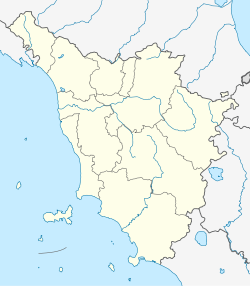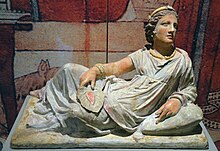world.wikisort.org - Italy
Chiusi (Etruscan: Clevsin; Umbrian: Camars; Ancient Greek: Klysion, Κλύσιον; Latin: Clusium) is a town and comune in the province of Siena, Tuscany, Italy.
This article needs additional citations for verification. (March 2019) |
Chiusi | |
|---|---|
Comune | |
| Città di Chiusi | |
 | |
 Coat of arms | |
Location of Chiusi  | |
 Chiusi Location of Chiusi in Italy  Chiusi Chiusi (Tuscany) | |
| Coordinates: 43°01′N 11°57′E | |
| Country | Italy |
| Region | Tuscany |
| Province | Siena (SI) |
| Frazioni | Chiusi Scalo, Macciano, Montallese, Querce al Pino |
| Government | |
| • Mayor | Juri Bettollini |
| Area | |
| • Total | 58.15 km2 (22.45 sq mi) |
| Elevation | 398 m (1,306 ft) |
| Population (31 December 2017)[2] | |
| • Total | 8,558 |
| Demonym(s) | Chiusini |
| Time zone | UTC+1 (CET) |
| • Summer (DST) | UTC+2 (CEST) |
| Postal code | 53043, 53044, 53040 |
| Dialing code | 0578 |
| Patron saint | St. Mustiola and St. Secondianus |
| Saint day | 17 June |
| Website | Official website |
History

Clusium (Clevsin in Etruscan) was one of the more powerful cities in the Etruscan League. Chiusi came under the influence of Rome in the 3rd century BC and was involved in the Social War.
In 540 AD it was occupied by the Ostrogoths and was later seat of a Lombard duchy. From the 11th century it was under the rule of the local bishop, and was later contended for by Orvieto and, from 1231, Siena, belonging to the latter until 1556, when it was annexed to the Grand duchy of Tuscany.
The region was devastated by malaria in the Middle Ages, and did not recover until the Valdichiana was drained in the 18th century.[3]
Main sights
The lowlands around Chiusi house numerous trove of tombs for this civilization. The Etruscan Museum of Chiusi is one of the most important repositories of Etruscan remains in Italy.
Other sights include:
- The Romanesque Cathedral (Duomo) of San Secondiano, built around 560 AD over a pre-existing basilica, and renovated in the 13th century. It has a nave and two aisles supported by antique columns made from marble taken from ancient buildings.[3] The Sacrament Chapel houses a Nativity and Saints by Bernardino Fugai. It has a separated bell tower which was turned into a defence tower in 1585. Under the tower is a Roman cistern dating from the 1st century BC.
- The so-called "Labyrinth of Porsenna", a series of tunnels under the town, built in the 6th-5th century BC and probably utilized in Etruscan-Roman times for drainage of rain waters. According to Pliny the Elder (Naturalis historia, XXXVI, XIX, 91-93), the Labyrinth was part of a monument including the sepulchre of the King Porsenna.
- National Archaeological Museum of Chiusi
Transportation
Chiusi is served by an interchange of the Autostrada A1. It is also served by Chiusi-Chianciano Terme station on the Florence–Rome railway, which connects Chiusi to major cities in Italy.
Twin towns
 Andrézieux-Bouthéon, France
Andrézieux-Bouthéon, France Neu Isenburg, Germany
Neu Isenburg, Germany
See also
- Lars Porsena
- Tomb of Lars Porsena
- Roman Catholic Diocese of Chiusi-Pienza
- Lago di Chiusi
References
- "Superficie di Comuni Province e Regioni italiane al 9 ottobre 2011". Italian National Institute of Statistics. Retrieved 16 March 2019.
- All demographics and other statistics: Italian statistical institute Istat.
- One or more of the preceding sentences incorporates text from a publication now in the public domain: Chisholm, Hugh, ed. (1911). "Chiusi". Encyclopædia Britannica. Vol. 6 (11th ed.). Cambridge University Press. p. 252.
External links
| Wikimedia Commons has media related to Chiusi. |
- Comune della Città di Chiusi, Official website (in Italian)
- Harris, W., R. Talbert, T. Elliott, S. Gillies. "Places: 413096 (Clusium)". Pleiades. Retrieved March 7, 2012.
{{cite web}}: CS1 maint: multiple names: authors list (link)
На других языках
- [en] Chiusi
[es] Chiusi
Chiusi es un municipio y localidad italiana de la provincia de Siena, en la región de la Toscana. Cuenta con una población de 8614 habitantes (2018).[ru] Кьюси
Кью́си (итал. Chiusi, лат. Clusium, Clusa, Camars, Clusa, Clusae, Clusina Civitas, Clusini Castellionis Castrum, этр. Clevsin, др.-греч. Κλύσιον, Klúsion) — коммуна в Италии, в регионе Тоскана, подчиняется административному центру Сиена.Другой контент может иметь иную лицензию. Перед использованием материалов сайта WikiSort.org внимательно изучите правила лицензирования конкретных элементов наполнения сайта.
WikiSort.org - проект по пересортировке и дополнению контента Википедии
